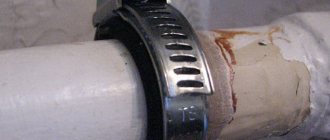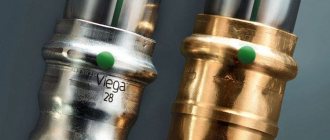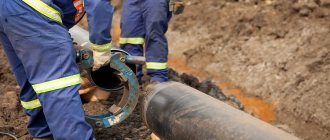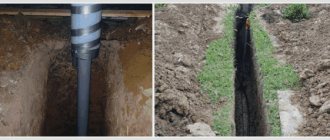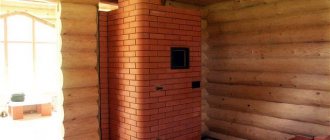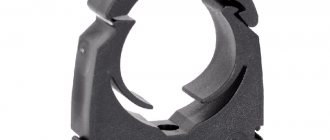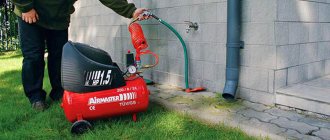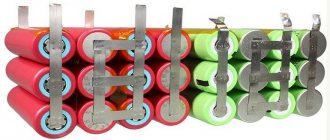When installing pipelines, welding is most often used to connect individual elements. But sometimes it is necessary to make the connection dismountable or to join elements made of different materials. In this case, a flanged pipe connection can be used. Let's figure out how it's done.
Flange connections are used when installing large-diameter pipelines, since the flanges used for joining parts are quite bulky and heavy. There are several types of flange connections, but they are all made in accordance with GOST requirements. Let's figure out which connection options using flanges are most often used.
general description
To connect two pipes, flanges are used, which are a flat ring (the flange can have another shape, for example, a square frame). In the center of the part there is a hole into which the end of the pipe is inserted.
Along the contour of the “frame” there is an even number of mounting holes intended for installing fasteners. Bolts or studs with nuts can be used for fastening.
When using flanges, the joints are detachable. In order to make the connection airtight, sealing gaskets are installed. Flanges are used to connect pipes to each other, as well as when connecting a pipe to a container that has an inlet pipe to which a flange is welded.
Flange fastener
Fasteners are parts that serve to permanently connect parts of machines and structures. These usually include connection parts: bolts, screws, studs, nuts, screws, screws, cotter pins, washers, rivets, pins and much more.
Fasteners are usually divided into two main groups:
1. General industrial fasteners , used in almost all sectors of industry and the national economy, which do not have narrow specialized characteristics.
2. Special-purpose fasteners are characterized by a highly specialized field of application (for example, automotive, railway, etc.).
Rice. 16 Flanges secured with fasteners
Such products are characterized by a clear focus on application in a specific area or even product (mechanisms, products, etc.), due to special characteristics.
Flange fasteners are designed for connecting pipeline parts. Flange fastener parts include: bolt, stud, nut, washer.
Bolt is a fastener for detachable connection of parts of machines and structures in the form of a rod with a thread at one end and a hex or tetrahedral head at the other.
Rice. 17. Bolt
Nut is a part of a threaded connection or screw drive that has a threaded hole. A fastening nut in a threaded connection is screwed onto the end of a bolt or stud or onto a threaded section of a shaft or axle to secure the parts sitting on them - rolling bearings, pulleys, etc. - from axial movement.
Rice. 18 Nut
A washer is a part placed under a nut or screw head. General purpose washers are used to increase the support area if the supporting surface is made of soft material or uneven, and also if the hole for the screw is oblong or of increased diameter. Oblique and spherical washers are used to eliminate misalignment of the nut or screw head when tightening. A quick-release washer is used in devices to save time on removing a machined part and installing a new one. A sealing washer made of soft material is placed under the head of the screw plug to ensure the tightness of the connection. A spring washer reduces the risk of screws or nuts unscrewing due to the elastic forces of the compressed washer. A locking washer, by bending its parts, eliminates the possibility of turning the nut or screw relative to the supporting part or shaft. End washers prevent axial movement along the shaft of parts that are stationary or rotating on the shaft.
Rice. 19 Washer
A stud is a fastener that is a metal rod with threads on both ends. The end of the stud is screwed into one of the parts to be joined, and the other part is pressed against the first when screwing the nut onto the other end of the stud. It is also possible to connect the parts with a pin, onto the ends of which nuts are screwed. There are a large number of regulatory documents that formulate technical requirements for fasteners. For example, the requirements for fasteners used in flange connections are set out in GOST 20700-75. These requirements are determined by operating conditions: operating pressure, environmental characteristics, etc. The design and dimensions of fasteners are regulated in GOST 9064-75, 9065-75, 9066-75.
Rice. 20 Hairpin
Manufacturing materials and types
To connect metal pipes, flanges made of the following materials can be used:
- Gray cast iron. Parts are made by casting. The use of these parts is permitted at operating pressures up to 16 MPa. The temperature of the transported medium must be in the range from -15 to +300.
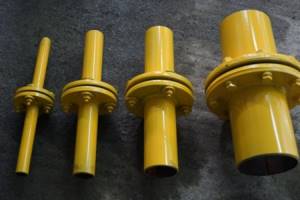
- Cast iron is malleable. Parts are manufactured by casting. It is allowed to be used for installation of pipelines with a working pressure of up to 4 MPa, but the operating temperature range is wider - from -30 to +400.
- Steel. Cast steel flanges can be used to connect pipes made of different materials. The maximum operating pressure is up to 20 MPa, the temperature range is very wide - from -250 to +600 degrees.
- Steel. Welded flanges are used for assembling pipelines operating at low pressure - up to 2.5 MPa.
Advice! For the manufacture of flanges, different types of steel are used - alloy, carbon, stainless.
Relatively recently, flanges made of polymer material began to be used. Polypropylene parts are used on plastic pipelines operating without pressure (or with low pressure). Depending on the purpose, there are two types of flanges:
- Walkthroughs. They are used to connect the pipe to other parts of the pipeline.
- Deaf. Installed in dead-end branches of the highway.
Scope of application
It must be understood that the flange does not act as a separate fastening component. Its immediate task is to provide a supporting area for fastening elements (for example, bolts) and at the same time create maximum tightness at the joint.
As a connecting and locking device, flanges have found application in the oil refining industry and in absolutely all communications related to housing and communal services. Their frequent installation in the gas and fuel areas has been noted. This is where precise and reliable flange-type fastenings are needed, which are indispensable when inserting measuring instruments into networks.
Various types of pipeline flange connections and their technological features make it possible to use engineering branches effectively and for a long time. This factor is of great importance, especially when it comes to transporting aggressive substances under high pressure.
If we talk about the arrangement of steel pipelines, fastening disks made of a similar material are most often used for them. In this way, a single load pressure indicator is set and reliable safety net is provided for working parts exposed to sudden temperature changes.
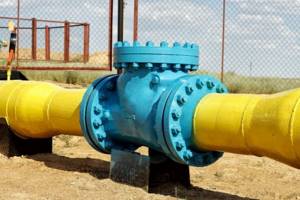
Damage is usually detected at the joining seams of materials that differ in thermal conductivity. If we are talking about steel pipelines, in some sections it is customary to install flanges made of brass, aluminum, bronze, and brass. However, parts made of carbon steel remain the undoubted leader, the reason for this is the following factors:
- practicality;
- affordable price;
- easy processing process.
Flange connections are found frequently and in almost every area of human life. Due to the use of various materials during production, the possibility of using them in almost any highway opens up.
Principle
To connect pipes with flanges, it is necessary that fasteners be installed at the ends of both parts being connected. Moreover, these parts must be identical, otherwise it will be impossible to make a hermetically sealed connection between the parts.
Advice! Flanges installed at the ends of the parts to be welded are called counter flanges.
The flange is attached to the end of the pipe in one of two ways:
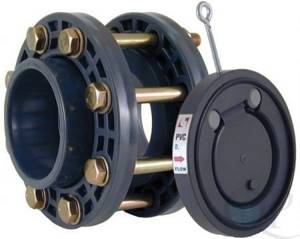
- on thread (applicable only for non-pressure pipelines);
- by welding.
After both counter flanges are installed, they are connected and tightened using fasteners.
Advice! A stud, unlike a bolt, does not have a head. The thread is cut on the stud on both sides. Thanks to this, when making a connection, you can tighten the flanges on both sides by screwing the nuts onto both sides of the stud.
Choice
Like any other fittings used to assemble pipelines, flanges are available in different sizes. Let's figure out what characteristics you need to pay attention to.
Conditional passage
This is a very important characteristic. The nominal diameter of the flange is, in fact, the internal diameter of the pipe on which this part is installed. This parameter is designated by the letter DN and measured in mm. For welded flanges, a Latin letter is indicated along with the nominal diameter; the letter indicates the outer diameter of the pipe.
Row
Parts that have the same nominal diameter are not always the same. Another important parameter is rowing. Model differences:
- in the difference between the center distances of the mounting holes;
- diameter of mounting holes.

Operating pressure
When choosing fittings, it is very important to pay attention to such an indicator as the working pressure in the pipeline. This indicator is determined by the maximum possible pressure at which the pipeline can operate without leaks at the dismountable joints. Conditional pressure indicators depend on the following parameters:
- geometric dimensions of parts;
- material of manufacture;
- presence and material of the sealing gasket.
Working temperature
This indicator is no less important, since if the maximum values are exceeded, a leak may form at the flange connections. The parameters of operating pressure and operating temperature depend on each other, therefore these indicators are indicated in special tables in the accompanying documentation for the product.
Basic parameters of flange fasteners
8.1 Operating pressure
This is the pressure with which liquid (gas, steam, etc.) is transported through the system. Consequently, the higher the operating pressure in the system, the higher the strength characteristics it is necessary to select fasteners. In turn, the necessary strength characteristics of fasteners are ensured by the correct choice of material, heat treatment modes, etc. Thus, in the temperature range from -40 to + 400 ° C, and at pressures up to 100 kgf/cm2, it is recommended to use fasteners made from steel 35, while increasing pressure to 200 kgf/cm2 requires the use of fasteners made of steel 20X13.
8.2 Operating temperature
One of the most important parameters is the operating temperature. Based on the temperature of the medium that will be transported through the pipeline, as well as taking into account the external environment, the grade of steel from which the fasteners will be made depends. Each grade of steel has a certain range of operating temperatures at which the fastener can provide strength and reliability of the connection.
For example, at the same nominal pressure at a temperature not lower than -30 °C, it is recommended to use studs made of steel 35, while at an expected operating temperature of up to -70 °C, fasteners made from cold-resistant steel grades, for example, 09G2S, should be used or 10G2.
8.3 Operating environment
There are certain characteristics of the working environment: temperature, chemical properties (composition - aggressive, non-aggressive).
In accordance with the above indicators, flange fasteners should be selected. For aggressive environments, fasteners are selected that can withstand the negative destructive influence of this environment. These steel grades include 20X13,14X17N2, 12X18N9T and others.
8.4 Thread diameter
All threaded fasteners have an internal (nuts) and an external (studs and bolts) thread diameter. Depending on the purpose and the regulatory document according to which the product is manufactured, the thread can be metric or inch. Metric thread pitch is measured in millimeters, and inch thread pitch is measured in inches.
Example: M12 - metric thread with a nominal diameter of 12 mm 3/4" - inch thread with a nominal diameter of 3/4 inch.
8.5 Thread pitch - the distance between two adjacent thread tips.
Depending on the purpose of the fastener, most regulatory documents provide for the possibility of manufacturing fasteners with different thread pitches (large or fine thread pitch). As a rule, the coarse thread pitch is the main one and is not indicated when ordering the product.
In some cases, a thread pitch may be made that differs from that recommended by regulatory documents.
Example: M12x1.25 bolt - a bolt with a metric thread, a nominal diameter of 12 mm and a fine thread pitch of 1.25 mm.
8.6 The turnkey size is equal to the diameter of the inscribed circle.
As a rule, one turnkey value is provided for each nominal thread diameter.
Example: for a nut with a nominal thread diameter of 16 mm, a spanner size S of 24 mm is provided.
8.7 Bolt length - the length indicated in the product designation when ordering, in most cases is not a dimensional characteristic. Mostly, the length of the bolt indicated in the product designation is equal to the length of the bolt shank, i.e. the height of the bolt head is not taken into account.
Example: for a bolt M12x120 - the length of the bolt shaft is 120 mm, while the total overall length is greater by the height of the bolt head by 7.5 mm, i.e. the total overall length is 127.5 mm.
8.8. Stud length
For most studs, the length specified when ordering is the overall overall length of the stud. However, some regulatory documents do not include the entire length of the stud in the designation of studs.
Example: GOST 22032-76, which applies to studs with a screw-in end of length dv, provides for the designation of the length of the stud, which does not include the length of the screw-in end.
8.9 Threaded end length - the length of the part of a bolt or stud intended for screwing on a nut.
8.10 Coverage
If it is necessary to protect a fastener from the negative effects of the environment, it is possible to apply various protective coatings (zinc, chromium, nickel, etc.) to its surface.
Selection of flange fasteners
Flange fasteners are selected in accordance with the following documents: GOST 20700-75; GOST 12816-80; GOST 9064-75; GOST 9066-75; PB 10-115-96; PB-03-75-94; OST 26-2043-91; OST 26-2037-96; OST 26-2038-96; OST 26-2039-96; OST 26-2040-96; OST 26-2041-96 and other regulatory documents regulating the use of fasteners depending on their purpose.
In order to choose the right fasteners, you need to remember that they will be equipped with a specific flange connection, therefore, you need to take into account the following parameters:
operating pressure
working temperature
working medium (gas, water, steam, oil, etc.)
external environment
In addition to the above parameters, the choice of fasteners is also influenced by the grade of steel from which the flange is made. The most commonly used steel grades of flanges are considered and recommendations are given on options for equipping them with flange fasteners:
1. There are certain restrictions on the choice of fastener type for a flange connection. At pressures up to 25 kgf/cm2. You can install either a bolt or a stud. At a pressure above 25 kgf/cm2, according to GOST 12816-80, the use of bolts is not allowed.
2. For flange connections, there are a large number of recommended grades of material for assembly. When making a nut-stud fastening pair from the same grade of steel, the hardness of the nut should be 20 units less than that of the stud. This is due to the fact that if excess pressure occurs in the system, the stud will likely be damaged, but the nut will not be damaged. In this case, it will be more difficult to identify the problem. If the stud is made by thread rolling, then GOST 20700-75 allows the production of a pair from a material with the same hardness.
Gasket selection
Gaskets must be used to seal the connection. It is especially important to correctly calculate the degree of sealing when operating a pipeline under pressure. The choice of material for the manufacture of gaskets depends on the operating conditions and the properties of the transported medium. Most often used:
- Rubber. Depending on the properties of the environment, a material is selected that is resistant to acids and alkalis, oil and petroleum products, and temperature.
- Paronitis. General purpose or oil resistant material can be used.
- Fluoroplastic.
- Asbestos cardboard.
The gasket is cut to the shape of the flange; its thickness depends on the selected material.
How is the connection made?
The most important point of installation is tightening the flange connection. It is important to achieve maximum sealing of the joint.
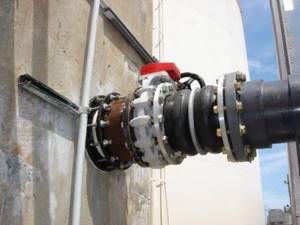
Preparatory stage
First of all, you need to inspect the connecting surfaces of the flanges; there should be no noticeable defects in the form of potholes and scratches. There should be no traces of corrosion.
Advice! It is necessary to inspect not only the flanges themselves for defects, but also the fasteners - bolts (studs) and nuts.
It is recommended to first “run” the nuts along the bolt threads to make sure that there are no defects on the threads. Next you need to install the new gasket, making sure that it is positioned correctly.
It is not recommended to install the old gasket during disassembly and subsequent reassembly. As a last resort, it is permissible to install 2-3 used gaskets, provided that they do not have obvious damage.
How is tightening done?
To ensure even tightening, the bolts must be tightened in a specific sequence. It is recommended to do the work like this:
- the first bolt (any) is lightly screwed on;
- the second one tightens (also lightly) the bolt located opposite the first one;
- the third bolt, which should be slightly tightened, is located at an angle of about 90 degrees with respect to the first and second;
- The fourth bolt to work with is opposite the third.
Thus, if a flange with four holes is used, then the bolts are tightened using the “crosswise” principle. If a part with six holes is used, then the first four bolts are tightened in the same way, then work with the fifth bolt located between the first and third, and the last bolt located between the second and fourth is tightened.
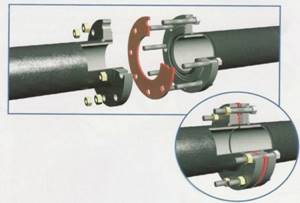
Having completed this stage, they begin to gradually tighten the bolts in the same sequence. To ensure a tight connection, the bolts must be tightened with a certain force.
If you overdo it, you can break the thread, and if the tightening is uneven, you won’t be able to achieve a tight seal. To ensure uniform tightening force, use special devices:
- torque wrench - manual or hydraulic;
- pneumatic impact wrench;
- tensioning mechanism with hydraulic drive.
After starting the pipeline, during the first day of operation it is possible to loosen the tightening within 10%. Therefore, on the second day after starting the system, it is necessary to further tighten the connections.
So, flanges can be used to create a collapsible pipeline connection. Despite the relative ease of making flange connections, installation work should only be performed by specialists. Especially if connections are made on pipelines for transporting hazardous media (for example, domestic gas). Work on pressure pipelines and flange connections are carried out under the supervision of engineers.
Types of fittings by connection method
What types of fittings are there according to the method of connection to the main pipeline? Mainly used are crimping, bolted, adhesive, soldered, and threaded. The latter allow easy disassembly and cleaning, but do not allow connecting pipes of different diameters. Welded and bolted allow joints of pipes of different (albeit adjacent) sizes.
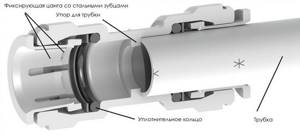
Adhesive and soldered are used for working with various non-metallic materials. In this case, the fitting looks like the main part of the pipeline: this makes it easier to identify and use the required soldering/gluing modes.
Provided that the installation is of high quality, welded and flanged versions can withstand the greatest loads, while adhesive and soldered versions can withstand the least loads.
